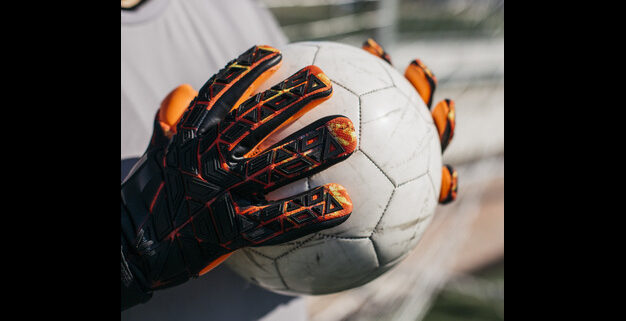How to Measure Your Goalie Glove Size
Goalkeeper gloves remain essential for soccer goalkeepers because they provide support while maintaining secure grips and comfort on the field. Proper glove sizing delivers enhanced ball control and injury prevention benefits.
Proper glove fit becomes a problem for numerous players since most cannot find suitable gloves, which results in performance reduction on the field. This briefing demonstrates the correct method to get precise measurements of your goalie glove dimensions while sharing important guidelines for suitable glove selection.
Professional sizing matters for new and experienced goalkeepers because it will enhance both performance abilities and glove fit.
Goalie Glove Sizing Basics
With goalkeeping gloves, you must understand fundamental size measurements before starting the measurement process. The size system for goalkeeper gloves operates independently from other soccer equipment standards. In glove sizing methods, the focus stretches beyond hand length measurements to treat hand circumference and finger proportions alongside it.
The input allows manufacturers to design gloves that mold to the hand exactly yet maintain adaptability when moving. Youth and adult gloves receive numbers 6, 7, 8, and 9, while adult sizes maintain the same pattern. Larger hand sizes might need to be selected between full sizes to attain a perfect fit.
An ideal fit allows minimal stretching of both your fingers and hand palm area without causing any performance reduction. You need to grasp these basic terms to achieve proper field performance from your chosen gloves.
Step-by-Step Measurement Guide
The correct process for accurately measuring your hand’s dimensions enables you to choose appropriate goalie gloves properly. The defined performance process results in glove fit, which leads to improved effectiveness. Below are the detailed steps to measure your hand for goalie gloves:
1. Measure Hand Circumference
You should use a flexible tape measure to wrap it once around your palm at its widest point, just underneath the knuckles. Avoid including your thumb when making measurements because glove sizing does not require it. Record the tape measurement in inches to identify the circumference. The glove width, together with its fit, depends on this measurement.
2. Measure Hand Length
Place your hand gently on a well-flat surface, and then measure its length, starting from your middle finger tip to the base’s edge. The glove fit needs this measurement length for comfortable palm placement and finger containment.
3. Account for Extra Room
Keep one inch beside the largest measurement you recorded between your hand circumference and length. An extra inch between your glove measurements enables better movement while wearing your gloves to avoid discomfort.
4. Check Both Hands
In most cases, the hands have a minor difference in size, with one being somewhat larger than the other. When selecting your glove size, use the larger measurement taken from your hands. The method guarantees optimal glove dimensions that suit your dominant hand.
5. Consult a Sizing Chart
Compare your hand measurements with the manufacturer’s sizing guidelines for gloves. This step ensures you choose the right glove size from different brands since their measurement systems only yield slight differences.
Custom hand measurements ensure you won’t experience glove discomfort, thus building both performance and physical comfort in matches.
See Also How to Wash and Dry Soccer Cleats in 5 Easy Steps?
Goalie Glove Size Charts
The glove manufacturers supply standardized size charts, which help participants find their perfect fit. Below is a general reference chart:
Youth Sizes
- Size 4: Hand circumference of 5–6 inches
- Size 5: Hand circumference of 6–6.5 inches
- Size 6: Hand circumference of 6.5–7 inches
Adult Sizes
- Size 7: Hand circumference of 7–7.5 inches
- Size 8: Hand circumference of 7.5–8 inches
- Size 9: Hand circumference of 8–9 inches
- Size 10: Hand circumference of 9–10 inches
The glove dimension charts differ slightly between different manufacturer brands. Ensure your glove manufacturer gives you proper charts that accurately reflect their products’ sizes.
Tips for Choosing the Right Goalie Gloves
Measuring goalie gloves approval extends past dimensions alone. All ,glove elements including the materials and features, and design choice, actively affect performance outcomes. This guide presents several important guidelines to assist you with your selection.
· Consider the Material
Goalie gloves typically exist in two material forms, including latex and synthetic components. Gloves from latex material create outstanding hand grip, which works perfectly for professional gameplay, yet their lifespan is shorter.
Synthetic gloves stand out because their extended durability pairs with monetary affordability and are suitable for training exercises and intensive surfaces.
· Look for Finger Protection
Your athletic goal should include finger-protecting gloves because frequent finger injuries are expected. Special finger-strengthening spines and inserts inside these gloves stop players from bending their fingers backwards while playing. Pure latex version of catcher gloves produces superior safety features at no expense to movement, so players of every age group can use them in competitions.
· Decide on the Cut
How material threads into glove structure determines glove cut design. A secure glove fit exists in roll-finger devices since they allow great ball control. Flat palm gloves provide peak comfort during matches of extended duration because they have a relaxed fit and cushioned protection.
Hybrid glove cuts merge rolling finger and flat palm gloves to deliver protective capabilities and comfort properties.
· Ensure Sufficient Padding
The correct padding absorbs shock to assist the player when blocking high-energy shots. As you shop for gloves, find products that include generous palm and backhand padding. Padding should be sufficient in your tennis gloves, but excessive padding might lower your grip flexibility, so finding a thickness that matches your playing method is vital.
· Try Before Buying and Check Return Policies
Gloves testing should be possible before purchase to verify a proper fit. To purchase gloves online, verify with the vendor that they allow exchanges when the fit does not match your size. Peak field performances require both comfort and confidence for athletes.
Working through these considerations enables you to find gloves that support your overall needs and enhance your goalkeeping conduct.
See Also Dynamic Stretches for Soccer Matches: Boost Your Agility and Prevent Injuries
Goalie Glove Fitting Problems and Solutions
The usage of appropriate measurement techniques does not eliminate potential fit-related problems. Below are some common fitting problems and practical solutions:
1. Gloves Feel Too Tight
Wearing gloves that feel too snug indicates inaccurate measurement, so try a one-half the size and larger glove. Too-small gloves create performance issues by limiting movement and reducing blood flow to play-dependent hand muscles. Remember to add an extra inch to your sizing measurements.
2. Gloves Are Too Loose
Incompetent ball handling occurs when loose-fitting gloves fail to stay put when security matters. You should readjust and tighten the wrist straps. When the issue continues to be present, you should pick a glove that is one size smaller than your normal selection. Gloves need to provide wearable security without limiting your range of motion.
3. Fingers Feel Cramped
You can tell gloves offer a poor fit when your fingers remain cramped since either the lengths match your hands badly or the stitch design doesn’t match your hand structure. Stretch gloves with extended finger lengths and consider roll finger designs if hand spacing remains an issue.
4. Palm Feels Slippery
A slippery glove interior may indicate improper hand coverage because of a lining problem. Your selection of correct glove size matters, and you should choose materials with enhanced grip potential or integrated anti-slip properties for maximum control.
Resolving these typical problems results in improved fit alongside enhanced goalkeeper comfort and satisfaction. Glove selection requires patience when you try out various sizes and styles. This process later leads to game improvement.
Materials and Design of Goalie Gloves
The choice of materials in goalkeeper gloves creates differences in comfort, durability, and performance abilities. Latex material forms the palm inside the glove, giving wearers outstanding grip quality and protective element. Synthetic palms supply longer durability than natural counterparts yet provide a reduced grip performance.
Breathable fabrics and padded materials constituting the back side of gloves help protect athletes. Mesh panels added to gloves allow air circulation that stops your hands from sweating. How gloves close around the wrist determines their fit and adjustability.
See Also Science Behind Soccer: Analyzing the Game’s Strategies and Techniques
Custom Goalie Gloves vs. Standard Gloves
Customizable goalie gloves represent an option for athletes seeking perfect hand dimensions alongside chosen design elements. The gloves are personalized to your hand sizes, which ensures maximum comfort and performance benefits.
Through customization options, players can select the preferred materials while choosing colors and adding features, including finger protection and personalized logos. Due to their tailored nature, custom-made goalie gloves require greater production time and cost more money.
Regular gloves are easily accessible to players while serving the requirements of different players through their basic general fit configuration. The current selection includes gloves in different styles and sizes, which support various customer needs and financial ranges.
Conclusion
Accurate measurement of goalie glove size is essential because it leads to better performance and improved wearer comfort. Enhanced grip performance, easy control, and strategic protection, becomes possible through gloves that fit securely.
Proper glove selection follows learning basic sizing information, measuring correctly, and examining size charts. When selecting gloves, choose between standard or custom options by prioritizing materials and ensuring they fit your requirements.
When you address common fitting issues, you stay focused and confident on match day. Objective soccer gloves allow keepers to advance their playing abilities and minimize dangerous sideline incidents.



